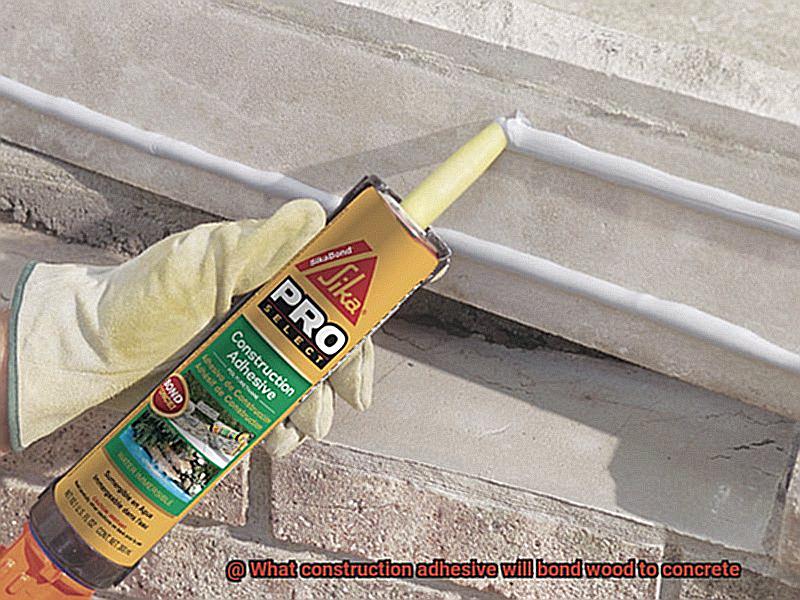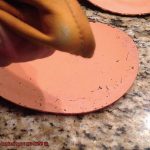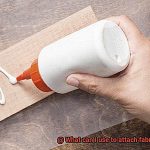Picture this: you’ve spent endless nights dreaming up the perfect backyard oasis or a cozy hideaway in your attic, only to face the daunting challenge of attaching wood to unyielding concrete. But fear not. In this blog post, we’re about to spill the beans on a construction adhesive that will effortlessly bind wood to concrete, creating a rock-solid connection that will stand the test of time.
Throughout history, humans have ingeniously joined different materials together, and construction adhesives have been the secret weapon behind these transformative creations. But when it comes to uniting wood and concrete – two seemingly incompatible elements – finding the right adhesive is crucial.
Today, we’re unveiling the ultimate solution – a construction adhesive that’s like a match made in building-materials heaven. It boasts unrivaled strength, durability, and adaptability. By boosting your adhesive knowledge, you’ll confidently tackle woodworking projects like building a rustic pergola, designing stylish flooring schemes, or even crafting imaginative architectural wonders.
In this enlightening journey, we’ll delve into the key factors that make a construction adhesive perfect for bonding wood to concrete. From understanding its chemical composition to mastering the necessary prep work for optimal adhesion – we won’t leave any stone unturned in our quest for the ideal bonding solution.
So if you’ve longed for an effortless union between wood and concrete, sit back and relax as we guide you through the captivating world of construction adhesives. Get ready to unlock the potential of this mighty bond that can transform your home or outdoor spaces from mere dreams into tangible havens.
Types of Construction Adhesives
Contents
- 1 Types of Construction Adhesives
- 2 Polyurethane Adhesives for Bonding Wood to Concrete
- 3 Epoxy-based Adhesives for Bonding Wood to Concrete
- 4 Surface Preparation for Effective Bonding
- 5 Applying Construction Adhesive Properly
- 6 Curing Times and Application Methods
- 7 Testing the Adhesive on a Small Area
- 8 Factors to Consider When Selecting an Adhesive
- 9 Conclusion
When embarking on construction projects, selecting the right adhesive to bond wood to concrete is paramount for establishing a robust and enduring connection. With a plethora of construction adhesives available, it is essential to choose one that suits the specific requirements of your project.
In this comprehensive guide, we will delve into five distinct types of construction adhesives specifically designed for bonding wood to concrete.
Polyurethane Adhesive
Polyurethane adhesive stands as a popular choice for its unparalleled strength and versatility when bonding wood to concrete. This adhesive exhibits remarkable resilience, creating a flexible bond that can withstand dynamic movement and fluctuating temperatures.
Its exceptional resistance to moisture makes it suitable for both indoor and outdoor applications, ensuring a reliable bond even in damp or humid conditions.
Epoxy Adhesive
Epoxy adhesive emerges as another formidable option for bonding wood to concrete. Comprising two components: resin and hardener.
Construction Adhesive with a Polyvinyl Acetate (PVA) Base
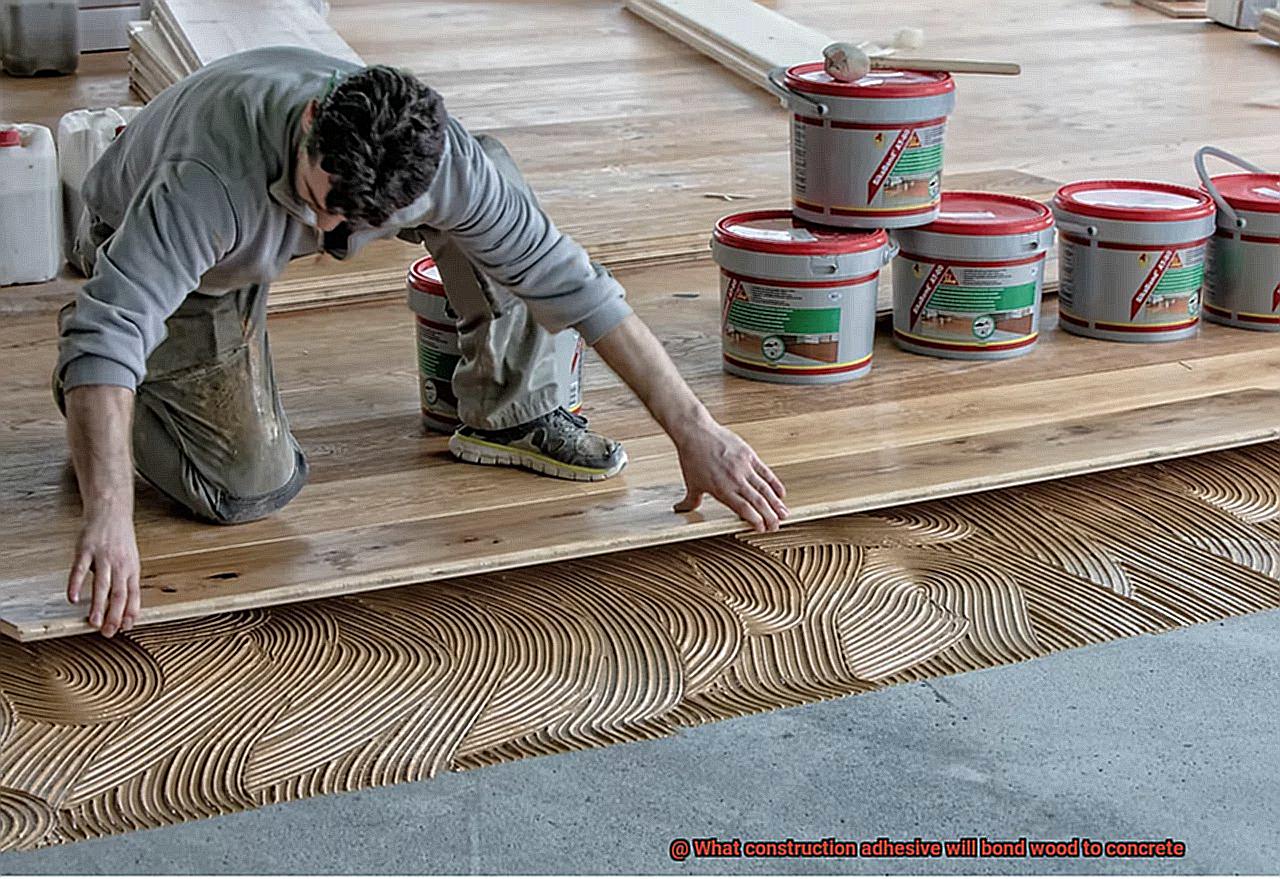
For lighter-duty projects or applications with less demanding bond strength requirements, construction adhesives with a PVA base come to the fore. These user-friendly adhesives offer a strong initial bond, making them easy to work with.
However, they may not possess the same level of durability as polyurethane or epoxy adhesives, particularly in high-stress situations or areas prone to moisture exposure.
Consequently, they are better suited for projects that require less load-bearing capacity.
Construction Adhesive with a Solvent-based Formula
When immediate bonding is of utmost importance, look no further than solvent-based construction adhesives. Renowned for their quick-drying properties and robust initial bond strength, these adhesives are go-to choices for time-sensitive construction projects.
However, it is important to note that the presence of volatile organic compounds (VOCs) in these adhesives may emit strong odors during application. Therefore, proper ventilation is imperative to ensure a safe and comfortable working environment.
Construction Adhesive with a Cyanoacrylate (CA) Base
For small-scale projects or repairs necessitating instant bonding, construction adhesives with a cyanoacrylate base, more commonly known as super glues, prove to be invaluable. These fast-setting adhesives establish an incredibly strong bond between wood and concrete surfaces in mere moments.
Polyurethane Adhesives for Bonding Wood to Concrete
When it comes to marrying wood and concrete, the quest for an unyielding bond can seem elusive. Fear not, for the answer lies in the form of polyurethane adhesives – the unsung heroes of construction.
In this article, we will delve into their exceptional qualities and explore why polyurethane adhesives are the ultimate choice for bonding wood to concrete. So, don your hard hat and prepare to be amazed by the power duo.
Versatility: The Chameleons of Adhesives
Polyurethane adhesives are the epitome of versatility in the adhesive realm. They effortlessly adapt to any environment, making them indispensable for both indoor and outdoor applications. Whether you’re erecting wooden structures amidst nature’s elements or embarking on an indoor woodworking project, polyurethane adhesives are your steadfast partners, ready to conquer any construction challenge.
Gap-Filling Capabilities: Bridging the Divide
The union of wood and concrete can be a puzzling affair, with irregular surfaces threatening to disrupt harmony. Enter polyurethane adhesives, armed with their remarkable gap-filling capabilities. Irrespective of uneven textures or idiosyncratic shapes, these adhesives seamlessly fill in gaps and create an unbreakable bond. Bid farewell to ill-fitting pieces, as polyurethane adhesives unite wood and concrete flawlessly.
Resistance to Moisture and Chemicals: Conquering Adversity
Moisture and chemicals are notorious adversaries that can undermine the integrity of our projects. However, with polyurethane adhesives in your arsenal, you can confidently face these challenges head-on. Their impressive resistance to moisture and chemicals ensures that bonding wooden flooring to a concrete subfloor in damp areas like bathrooms or kitchens becomes a worry-free endeavor. Let the adhesive shield be your protection against environmental threats.
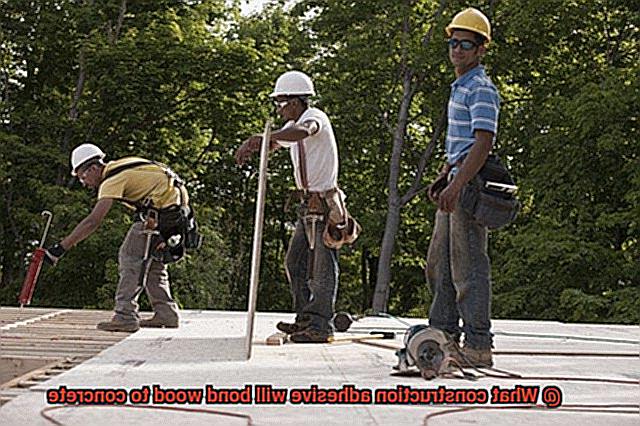
Epoxy-based Adhesives for Bonding Wood to Concrete
Today, we embark on a thrilling exploration of epoxy-based adhesives for bonding wood to concrete. Prepare to be captivated as we reveal the secrets behind this dynamic duo that conquers any construction challenge. So, strap on your hard hat and let’s dive in.
Understanding the Magic of Epoxy Adhesives
Enter the world of epoxy-based adhesives, the undisputed champions for bonding wood to concrete. These adhesive wonders are renowned for their exceptional strength and durability, making them the ultimate choice for applications where an unwavering bond is essential.
The Epoxy Recipe: Mixing and Curing
Unlocking their power requires blending two vital components – a resin and a hardener. These dynamic ingredients must be expertly mixed before application to trigger a chemical reaction that forges unbreakable cross-linking bonds. Remember, precision is key when following the manufacturer’s instructions on mixing ratios for optimal results.
Unyielding Bonding Capabilities
Behold the unshakable might of cured epoxy adhesives. With a remarkable load-bearing capacity, they fearlessly withstand heavy loads and stresses without breaking a sweat. Whether it’s supporting a massive wooden beam or securing a concrete countertop, epoxy adhesives stand strong against any challenge.
Defying the Elements: Moisture, Chemicals, and Temperature
Nature’s fury is no match for epoxy adhesives. Their exceptional resistance to moisture, chemicals, and temperature variations makes them equally suitable for both indoor and outdoor applications. Rain or shine, your wood-to-concrete bond remains impervious to the elements.
Prepping for Success: Clean and Roughen
Before unleashing the adhesive magic, cleanliness reigns supreme. Ensure that both wood and concrete surfaces are immaculately clean, free from dust, dirt, and grease. For an even stronger bond, consider roughening or etching the surfaces to provide the perfect grip for the adhesive’s embrace.
Surface Preparation for Effective Bonding
Prepare to be captivated as we unravel the secrets that will revolutionize your wood and concrete bonding game. Get ready to witness the power of proper surface preparation in creating bonds that can withstand the toughest challenges nature throws their way.
The Crucial Role of Surface Preparation:
Why does surface preparation hold the key to effective bonding, you ask? Picture yourself trying to stick two pieces of tape together without eliminating dust and debris. Not a pretty sight, is it? The same principle applies when bonding wood and concrete. By preparing the surfaces meticulously, we lay the foundation for a bond that will stand the test of time, defying even the harshest elements.
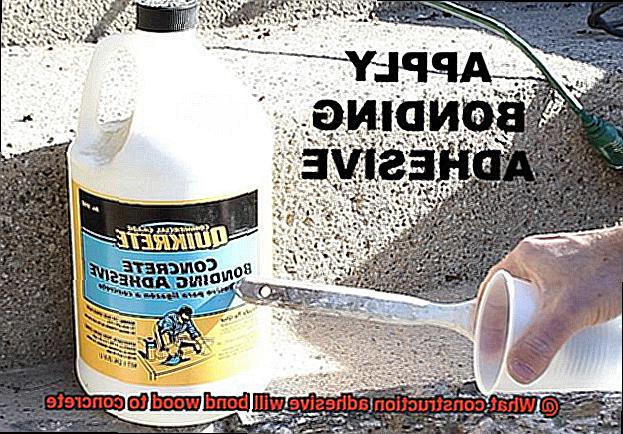
Step 1: Cleaning – A Fresh Canvas:
Our journey begins with cleanliness – the essential first step. Both wood and concrete surfaces must be pristine before any adhesive is applied. Bid farewell to dust bunnies, dirt smudges, and greasy stains. Take charge with your trusty brush or vacuum cleaner, ensuring no particle goes unnoticed. Let’s start with a fresh canvas.
Step 2: Drying – The Art of Patience:
Now that our surfaces are flawlessly clean, we embark on the art of drying. Moisture is the enemy of bonding, so patience is key. Allow both surfaces to dry completely – whether through air drying or the use of a drying agent. Remember, rushing this step could jeopardize the strength and longevity of your bond. Embrace the art of patience for a bond that endures.
Step 3: Roughening – Unleash Your Rebel Spirit:
Prepare yourself for the exhilaration of roughening those surfaces. Smooth finishes and coatings must be eliminated for an adhesive bond that holds like a champion. Gently sand the wood to remove any obstacles in the way. As for concrete, it may require a bolder approach – acid etching or mechanical abrasion. Unleash your inner rebel and create a rough texture that screams “stick with me.”
Applying Construction Adhesive Properly
Prepare to embark on a journey into the captivating world of construction adhesive. Today, we unveil the secrets to applying this versatile product properly, ensuring your wood and concrete surfaces bond like never before.
Get ready to revolutionize your construction game with techniques that will make your projects withstand even the harshest challenges nature throws their way.
Preparing the Surfaces:
Imagine a clean canvas, ready to be transformed into a work of art. That’s exactly what we need for our wood and concrete surfaces before applying construction adhesive. Banish dust, debris, and grease by wielding a brush or vacuum cleaner, followed by a thorough wipe down with a cloth. Remember, cleanliness is the foundation of a bond that can stand up to anything.
Creating Grip:
Smooth surfaces are no match for our champion adhesive bond. To enhance its grip, let’s add some texture. Sand the wood surface to give it a roughened edge, while the concrete surface calls for a wire brush or abrasive pad.
These simple steps create a slightly rough texture that will make the adhesive adhere better. Say goodbye to weak bonds caused by smooth finishes and coatings.
The Perfect Application:
Achieving an impeccable bond relies on applying construction adhesive evenly and in the right amount. Too little adhesive leads to weakness, while excessive application results in messiness. Fear not. We have the solution – your trusty caulk gun.
Cut off the tip of the adhesive tube at a 45-degree angle, insert it into the caulk gun, and gently squeeze the trigger to apply a thin bead of adhesive along one surface. With precise control and easy application, success is within reach.
The Power of Pressure:
Time waits for no one in the world of construction adhesive. Once applied, press those wood and concrete surfaces together with unwavering force. Immediate bonding is essential for a successful connection.
Distribute pressure evenly across the entire surface, ensuring maximum contact between the materials. Remember, you’re not just building a project; you’re creating a masterpiece.
Curing Times and Application Methods
In our previous discussion, we explored the remarkable connections that construction adhesive can create between wood and concrete surfaces. Today, we embark on a journey to uncover the secrets of curing times and application methods. These two key elements will guide us towards achieving bonds that withstand the tests of time and nature.
The Power of Curing Times:
Just like a fine wine, construction adhesives need time to mature and reach their full potential. Curing time refers to the duration it takes for the adhesive to dry completely and achieve its maximum bonding strength. Let’s delve into why this aspect is crucial:
Patience is a Virtue:
Different construction adhesives have varying curing times, so it is essential to follow the manufacturer’s instructions. While instant results may be tempting, allowing the adhesive enough time to fully cure is paramount.
Wood-to-concrete bonds often require longer curing times compared to other adhesives, but the wait is worth it for a bond that can withstand even the toughest challenges.
Factors at Play:
Curing times can be influenced by various factors, such as temperature, humidity, and adhesive thickness. Higher temperatures and lower humidity levels generally accelerate the curing process, while lower temperatures and higher humidity levels may slow it down. Keep an eye on Mother Nature’s whims when planning your project timeline.
Timing is Everything:
To ensure optimal results, it is recommended to let the adhesive cure for at least 24 hours before subjecting the bonded materials to stress or load. However, for an unbreakable bond that defies gravity, following the manufacturer’s specified full curing time is essential.
Mastering Application Methods:
Now that we’ve covered curing times, let’s dive into the art of applying construction adhesives for wood-to-concrete bonding. Here are some essential tips to guide you:
Cleanliness is Key:
Prepare a clean canvas for your masterpiece by ensuring both the wood and concrete surfaces are clean, dry, and free from any debris or contaminants. Remove dust, grease, or loose particles that could compromise the bond.
Testing the Adhesive on a Small Area
Today, we’re going to dive into a crucial step in the wood-to-concrete bonding process – testing the adhesive on a small area.
Just like a chef tastes a small sample before serving a whole dish, we need to ensure that our adhesive is up to the challenge of creating unbreakable bonds. So, grab your lab coat and safety goggles as we explore the steps to conduct this mini-experiment.
Step 1: A Clean Slate
Cleanliness is key. Before we get down to business, let’s make sure our surfaces are as clean as a whistle. Grab your trusty wire brush or vacuum cleaner and banish any pesky particles from both the wood and concrete surfaces. We want these materials to be as friendly as peanut butter and jelly when they meet.
Step 2: Apply with Precision
Now it’s time to get artsy with our adhesive. Take a small amount of your chosen construction adhesive and spread it onto the wood surface. Remember, a little goes a long way. Use a putty knife or a small brush to ensure an even application. Don’t forget to consult the manufacturer’s instructions for specific application techniques and thickness.
Step 3: The Moment of Truth
Press that wood surface firmly onto the concrete section where you want it to bond. Apply some pressure for a few seconds, ensuring that these two materials get cozy and make sweet, sweet contact. This is where the true bond begins to take shape.
Step 4: Patience, My Friend
Ah, patience – the virtue that separates us from hasty DIY disasters. Allow the adhesive to cure according to the manufacturer’s recommended time. Remember, different adhesives have different curing times, so read those instructions like you’re savoring the latest bestseller. During this waiting period, resist the urge to poke, prod, or disturb the bonded surfaces. Let them work their adhesive magic in peace.
Step 5: The Moment of Truth…Again.
Once the recommended curing time has passed, it’s time to unveil your masterpiece. Carefully examine the bonded area for any signs of failure – peeling, cracking, or separation between the wood and concrete. If all looks well and the bond appears strong, congratulations. You’ve found yourself a winner.
Factors to Consider When Selecting an Adhesive
When it comes to bonding wood to concrete, selecting the right adhesive is a crucial step that can make or break your project. Just like a chef carefully selects the perfect ingredients for a delicious dish, you need to consider several factors before choosing an adhesive that will create an unbreakable bond.
In this comprehensive guide, we will explore the key factors you should consider when selecting an adhesive for this specific application. So let’s dive in and discover the secrets to successful wood-to-concrete bonding.
Bond Strength:
The first factor to consider is the bond strength of the adhesive. You need an adhesive that can withstand the weight and stress applied to it, creating a durable and long-lasting bond between wood and concrete. Look for adhesives specifically formulated for high bond strength, ensuring that your project stands strong for years to come.
Compatibility:
Next, it is crucial to choose an adhesive that is compatible with both wood and concrete surfaces. Different adhesives are designed for specific materials, so ensure that you select one suitable for bonding wood to concrete. This will prevent any issues such as peeling or delamination, guaranteeing proper adhesion.
Application Method:
Consider the application method of the adhesive. Some adhesives come in tubes and require a caulk gun, while others are available in spray or liquid form that can be conveniently applied using a brush or roller. Choose an adhesive that suits your project requirements, making the application process smooth and hassle-free.
Drying Time:
The drying time of the adhesive is another significant factor to consider. Depending on your project timeline, some adhesives may require longer drying times, while others dry quickly. Select an adhesive with a drying time that aligns with your needs, keeping in mind any additional support or clamping requirements during the drying process.
Weather Resistance:
For outdoor applications or projects exposed to varying weather conditions, it is vital to choose an adhesive with excellent weather resistance. Ensure that the adhesive can withstand moisture, temperature changes, UV rays, and other environmental factors without compromising its bond strength. This will ensure the longevity and durability of your wood-to-concrete bond.
wXu7Q_Dktm4″ >
Conclusion
When it comes to bonding wood to concrete, finding the right construction adhesive is key. You want a product that will provide a strong and durable bond, ensuring your wood stays securely in place. Luckily, there are several options available that are specifically designed for this purpose.
One popular choice is polyurethane-based adhesive. This type of adhesive forms a strong bond between wood and concrete, even in challenging conditions such as high humidity or extreme temperatures. It also has excellent resistance to water and chemicals, making it ideal for outdoor applications.
Another option is epoxy-based adhesive. Epoxy adhesives are known for their exceptional strength and durability. They create a powerful bond that can withstand heavy loads and vibrations. Additionally, epoxy adhesives have good resistance to moisture and can be used both indoors and outdoors.
For those looking for a quick and easy solution, there are also hybrid adhesives available. These adhesives combine the benefits of polyurethane and epoxy, offering fast curing times while still providing a strong bond. They are versatile enough to be used on various surfaces, including wood and concrete.
When choosing a construction adhesive for bonding wood to concrete, it’s important to consider factors such as the specific application requirements, drying time, and environmental conditions. Reading product labels and consulting with experts can help you make an informed decision.
In conclusion, whether you’re working on a DIY project or tackling a professional construction job, selecting the right construction adhesive is crucial when bonding wood to concrete. With options like polyurethane-based adhesives, epoxy-based adhesives, and hybrid adhesives available, you can find the perfect product for your needs.

